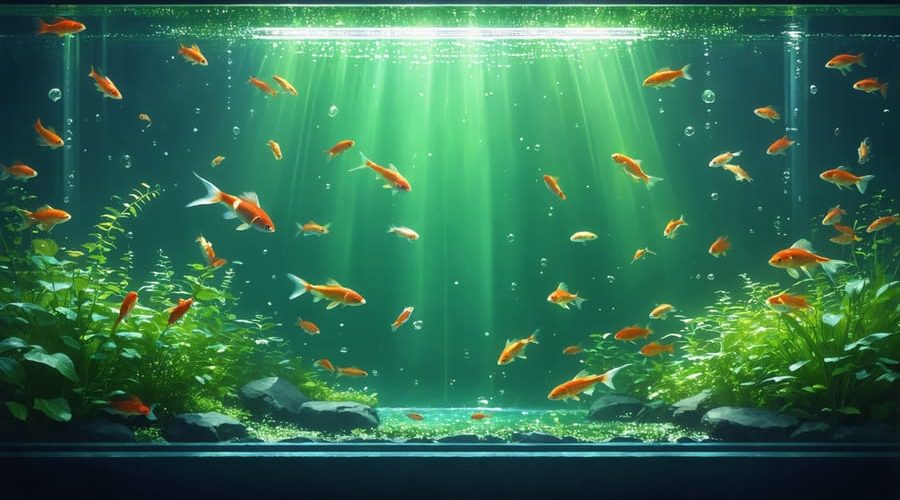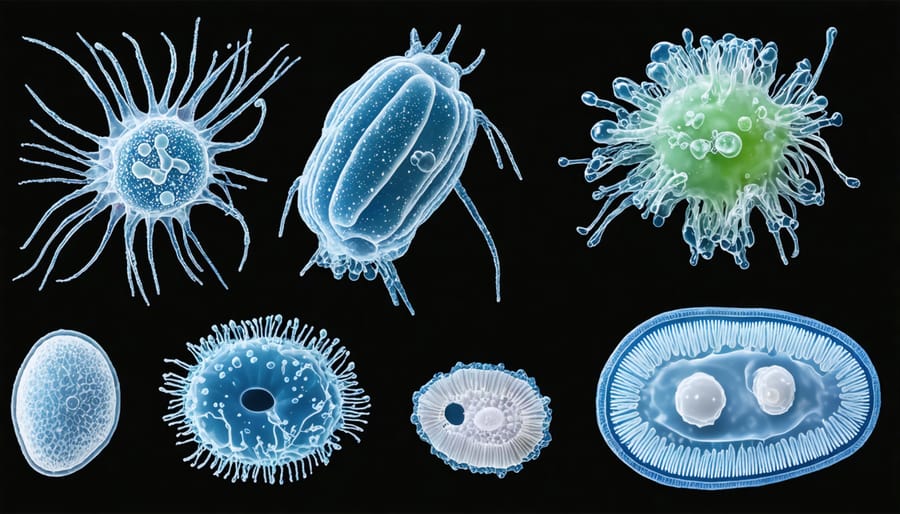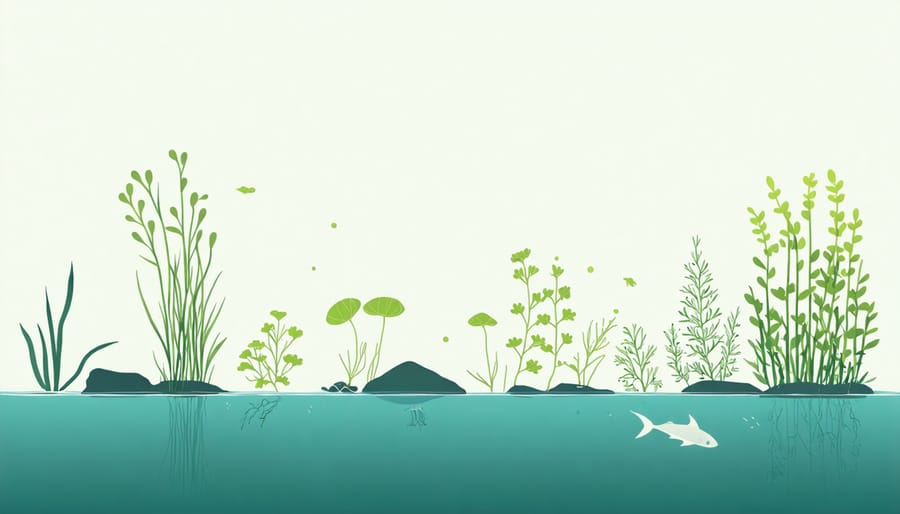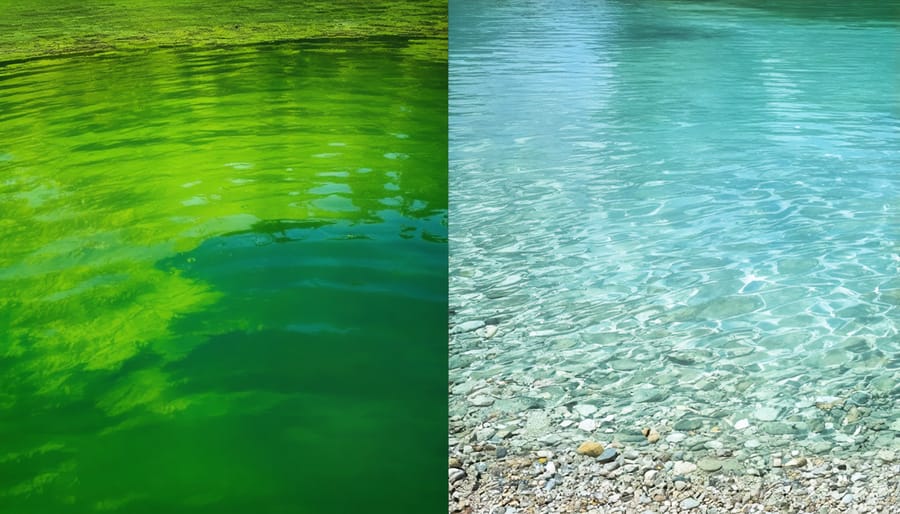
Why Phytoplankton Makes Your Fish Pond Thrive (And How to Maintain It)
Dive into the microscopic powerhouses that form the foundation of every thriving pond ecosystem. Phytoplankton, the tiny floating plants that give pond water its green tint, are nature’s unsung heroes. These microscopic organisms produce up to 80% of your pond’s oxygen, feed countless aquatic creatures, and help maintain crystal-clear water when properly balanced. Like a well-conducted orchestra, phytoplankton work in harmony with other pond elements to create the perfect balance between clarity and productivity. Understanding and managing these invisible gardeners isn’t just about maintaining water quality—it’s about nurturing a complete ecosystem that supports everything from beneficial bacteria to prize koi. Whether you’re a seasoned pond keeper or just starting your water gardening journey, mastering phytoplankton management will transform your pond from a simple water feature into a vibrant, self-sustaining aquatic paradise.
The Hidden Power of Pond Phytoplankton

Natural Fish Food Factory
Think of phytoplankton as nature’s own fish food factory in your pond. These microscopic plants form the foundation of your pond’s entire food chain, supporting everything from tiny zooplankton to your prized koi. When sunlight hits the water, phytoplankton transforms this energy into nutrients through photosynthesis, creating a natural buffet for small aquatic creatures.
These tiny organisms are especially vital for young fish fry, which feed on both the phytoplankton directly and the zooplankton that graze on it. As larger fish eat these smaller creatures, the nutrients from phytoplankton make their way up the food chain, supporting your pond’s entire ecosystem.
A healthy phytoplankton population means you’ll spend less on commercial fish food, as your pond essentially feeds itself. The key is maintaining the right balance – enough phytoplankton to support the food chain, but not so much that it causes water quality issues.

Nature’s Water Quality Manager
Think of phytoplankton as your pond’s natural water quality management team. These microscopic powerhouses are essential for natural pond oxygenation, producing up to 80% of the oxygen your fish and other aquatic creatures need to thrive. During daylight hours, they’re busy converting sunlight into energy while releasing oxygen as a beneficial byproduct.
But that’s not all! These tiny organisms are also excellent nutrient recyclers. They absorb excess nutrients like nitrogen and phosphorus that would otherwise feed unwanted algae growth. By taking up these nutrients, phytoplankton helps maintain the delicate balance in your pond’s ecosystem. Think of them as nature’s cleanup crew, working round the clock to keep your pond water clean and healthy.
When your phytoplankton population is just right, they’ll give your pond that sought-after emerald green tint while maintaining crystal-clear water conditions.
Creating the Perfect Environment for Phytoplankton
Nutrient Balance Basics
Maintaining proper nutrient levels in your pond is crucial for healthy phytoplankton growth. Think of nutrients as the food that keeps these microscopic plants thriving. The key players are nitrogen and phosphorus, which work together like a balanced meal for your pond’s ecosystem.
To keep things in check, aim for a nitrogen-to-phosphorus ratio between 10:1 and 16:1. Too much of either nutrient can lead to algae blooms, while too little can starve your beneficial phytoplankton. Regular water testing is your best friend here – try to check levels at least monthly during the growing season.
Adding nutrients doesn’t have to be complicated. Many pond owners use slow-release fertilizers specifically designed for ponds. Start with small amounts and monitor how your pond responds. A good rule of thumb is to maintain phosphorus levels between 0.02 and 0.05 parts per million.
Watch out for these warning signs of nutrient imbalance:
– Water that’s too clear (lacking nutrients)
– Pea-soup green water (excess nutrients)
– Strong algae smell
– Sudden changes in water color
If you’re adding fish food or using pond fertilizers, remember that these contribute to nutrient levels too. During hot summer months, you might need to adjust your nutrient management as warmer temperatures can affect how phytoplankton use available nutrients.
Keep in mind that every pond is unique, so what works for one might not work for another. Start conservative with additions and adjust based on your observations.
Light and Temperature Management
Managing light and temperature is crucial for maintaining healthy phytoplankton populations in your pond. These tiny organisms thrive best when they receive 4-6 hours of direct sunlight daily. While more sunlight isn’t necessarily harmful, too much can lead to excessive algae growth, so consider using floating plants to provide some shade if needed.
Temperature plays an equally important role, with most phytoplankton species preferring waters between 68-75°F (20-24°C). During hot summer days, using an aerator or fountain can help prevent temperature stratification and keep your pond water moving. This movement not only helps regulate temperature but also ensures phytoplankton stays suspended in the water column where it can photosynthesize effectively.
In winter, deeper ponds (at least 3-4 feet) provide better temperature stability for phytoplankton survival. If you live in a cold climate, consider using a pond heater or de-icer to maintain a small opening in the ice, allowing for gas exchange and preventing complete freezing.
Monitor your pond’s temperature regularly using a simple pond thermometer. Sudden temperature changes can stress phytoplankton populations, so try to maintain consistent conditions when possible. If you’re adding new water to your pond, make sure it’s close to the existing water temperature to avoid shocking the microscopic ecosystem.
Remember that seasonal changes are natural, and you’ll notice variations in phytoplankton activity throughout the year. This is perfectly normal and part of maintaining a healthy pond ecosystem.
Common Problems and Solutions
Algae Blooms
While phytoplankton is essential for pond health, too much of a good thing can cause problems. Algae blooms occur when these microscopic organisms multiply rapidly, turning your pond water into a thick, green soup. These blooms typically happen when there’s an excess of nutrients (especially nitrogen and phosphorus) combined with warm, sunny conditions.
To manage algae blooms, start by reducing nutrient inputs. Be careful not to overfeed fish, as uneaten food decomposes and releases nutrients. Install a pond skimmer to remove fallen leaves and debris before they break down. Adding floating plants like water lilies can help shade the water and compete with phytoplankton for nutrients.
Regular water testing is crucial to catch potential blooms early. If you notice your pond water becoming increasingly green, consider using an ultraviolet clarifier or adding beneficial bacteria that compete with algae for nutrients. In severe cases, you might need to perform a partial water change to dilute the concentration of nutrients.
Remember that prevention is easier than cure. Maintaining a balanced ecosystem with proper filtration and regular maintenance will help keep phytoplankton levels in check naturally.
Clear Water Issues
While clear water might look appealing, having water that’s too clear can indicate insufficient phytoplankton levels, which could impact your pond’s ecosystem. Many pond owners strive to maintain crystal clear pond water, but a slight green tint is actually healthy for your pond.
To boost phytoplankton levels, start by testing your water’s nutrient content. If phosphorus and nitrogen levels are low, consider adding pond fertilizer specifically designed for phytoplankton growth. Start with small amounts and monitor the water color – aim for a light green tint that allows you to see about 18-24 inches deep.
Adding beneficial bacteria can help break down organic matter and release nutrients that phytoplankton need to thrive. Regular aeration is also crucial, as it helps distribute nutrients and keeps phytoplankton suspended in the water column. Remember to maintain a balanced approach – too many nutrients can lead to harmful algae blooms, while too few will limit phytoplankton growth.

Seasonal Care Tips
Maintaining healthy phytoplankton levels requires different approaches throughout the year. During spring, as temperatures rise, gradually increase feeding rates and fertilization to support phytoplankton growth. This is when your pond’s ecosystem starts becoming more active, making it the perfect time to establish a strong phytoplankton base.
Summer brings intense sunlight and warmer waters, which typically encourage robust phytoplankton growth. Monitor your pond’s color regularly – aim for a light green tint that allows you to see about 18-24 inches into the water. If the water becomes too clear, consider adding pond fertilizer to boost phytoplankton populations. During hot spells, keep an eye on dissolved oxygen levels, as dense phytoplankton blooms can deplete oxygen overnight.
As fall approaches, gradually reduce fertilization rates. Phytoplankton growth naturally slows during this time, and overfeeding can lead to water quality issues. Install a pond aerator if you haven’t already – it’ll help maintain healthy oxygen levels as temperatures drop.
Winter requires minimal intervention. Phytoplankton activity decreases significantly in cold temperatures, which is completely normal. Focus on maintaining good aeration and avoid fertilizing during this period. If you live in a region with harsh winters, consider using a de-icer to keep a portion of the surface free from ice.
Remember that weather patterns and local conditions can affect these general guidelines. Always observe your pond’s specific behavior and adjust your care routine accordingly. Keep detailed records of your management practices and their results – this information will prove invaluable for fine-tuning your seasonal care strategy over time.
In closing, phytoplankton plays a vital role in creating a thriving pond ecosystem. These microscopic powerhouses not only provide essential oxygen for your fish but also help maintain water quality and create a natural food chain in your pond. By monitoring water clarity, maintaining proper nutrient levels, and ensuring adequate sunlight exposure, you can create the perfect environment for healthy phytoplankton growth.
Remember that successful pond management is all about balance. Too little phytoplankton can starve your ecosystem, while too much can lead to algae blooms. Start implementing the practices we’ve discussed, like regular water testing and proper filtration, to maintain optimal phytoplankton levels in your pond.
Consider keeping a pond journal to track changes in water quality and phytoplankton levels throughout the seasons. This will help you better understand your pond’s unique patterns and needs. With patience and consistent care, you’ll develop a deeper appreciation for these tiny but mighty organisms that make your pond come alive.
Take action today to nurture your pond’s phytoplankton population – your fish and the entire ecosystem will thank you for it!
